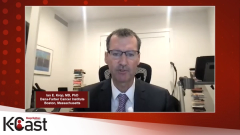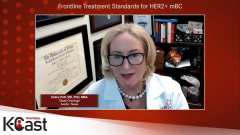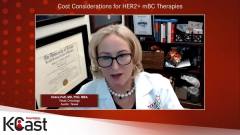
Newer Targeted Therapies for HER2+ Metastatic Breast Cancer
Ian E. Krop, MD, PhD, of Dana-Faber Cancer Institute, highlights more recent targeted therapy approvals for HER2-positive metastatic breast cancer and describes how each therapy is designed to work.
Episodes in this series

Briana Contreras: For our next series of questions, we’ll be reviewing the newer treatment regimens for HER2-positive metastatic breast cancer. For my first question, what are some of the newer targeted approaches that have been incorporated into practice?
Ian E. Krop, MD, PhD: This field has exploded in the last year and a half or so with 4 new drugs approved by the FDA in that time frame. It’s unprecedented to see that growth in a field. Prior to a year and a half ago, our standard treatments included the drugs we’ve already talked about, which are trastuzumab, pertuzumab, the tyrosine kinase inhibitor [TKI] lapatinib, and one drug we haven’t spoken about yet is T-DM1 [trastuzumab emtansine], which is an antibody-drug conjugate consisting of trastuzumab linked to a potent microtubule inhibitor. Those were the drugs that we had been using for multiple years in the HER2+ metastatic space. We typically used the trastuzumab, pertuzumab, and taxane regimen in the first line, as I mentioned. Then we would use T-DM1 [trastuzumab emtansine] in the second line because that had been shown in a randomized trial to have better efficacy than capecitabine and lapatinib.
Where things have changed a lot is in the third and later lines of treatment. Previously in that setting, we would typically use some type of chemotherapy along with trastuzumab, and rotate the chemotherapies as patients progressed. There were a lot of options, but they didn’t tend to work all that well. Typically, patients would have a response rate of less than 20% in that setting, and progression-free survival was typically 4 to 5 months. There were a lot of different options you could use for those later-line patients, but we clearly needed better options because the ones we had were pretty limited. That’s where things have changed is in this third- and later-line settings. The new drugs we have include another antibody-drug conjugate. This one’s called trastuzumab deruxtecan. It differs from T-DM1 [trastuzumab emtansine] in the payload connected to the antibody. The antibody is pretty much the same. It’s essentially trastuzumab, or at least it has the same amino acid sequences as trastuzumab. But it’s linked to a different class of chemotherapy. With trastuzumab deruxtecan, the payload is a topoisomerase 1 inhibitor.
This is a type of chemotherapy we typically don’t use in HER2-directed therapy. It’s unlikely that cancers would have developed resistance to this class of drug by the time they see trastuzumab deruxtecan. In addition, there are more payload molecules per antibody. Theoretically at least, it can deliver more chemotherapy to the cancer cell. The payload has what’s called bystander effect, meaning that once the conjugate binds to the cancer cell, the payload gets released into the cytoplasm of that cancer cell, but it can then diffuse out of that cancer cell and kill neighboring cancer cells, regardless of whether they make HER2. In a cancer that is heterogeneous for HER2, meaning that there may be a mixture of cancer cells that are highly HER2+, and maybe some that only have low or no HER2 levels, a drug with bystander effect may be more effective than a drug without. T-DM1 [trastuzumab emtansine] does not have that bystander effect, whereas trastuzumab deruxtecan does. That’s a new antibody-drug conjugate.
We have 2 new tyrosine kinase inhibitors. As I mentioned, lapatinib was the first TKI approved. There are now 2 more. One of them is neratinib, which is a very potent HER2 kinase inhibitor. It also blocks a related kinase called EGFR, or HER1, and HER4. That’s relevant because inhibition of EGFR results in toxicities like rash and diarrhea. This drug is very active and potent. But again, it does carry this liability of causing diarrhea and rash because of its effects on EGFR. Neratinib was approved after 2 lines of therapy based on a trial comparing neratinib and capecitabine versus lapatinib and capecitabine, showing that neratinib and capecitabine were more effective in terms of progression-free survival and prevention of need for interventions in the brain. Neratinib was approved in the setting in combination with capecitabine.
The second tyrosine kinase inhibitor that was approved recently is tucatinib. Tucatinib is a little different from neratinib and lapatinib in that it’s very specific for HER2. It doesn’t inhibit EGFR much at all, so it doesn’t have as much of that problem with diarrhea as these other agents do. Tucatinib was approved in combination with capecitabine and trastuzumab based on a trial called HER2CLIMB, which compared that regimen to capecitabine and trastuzumab and placebo. The addition of tucatinib led to significant improvements in progression-free and overall survival, as well as showing substantial activity in the brain, not only in improving survival in patients who had active brain metastases, but also showing response rates in the 40% range in the brain when treated with that combination of tucatinib, capecitabine, and trastuzumab.
The last agent that has been approved, which is the most recent approval, is an interesting new antibody called margetuximab. Margetuximab is essentially the same as trastuzumab, but it’s modified to have more immune effects. We’ve known for a long time that trastuzumab works at least in part by activating the immune system to attack the cancer cells. It does this by activating something called ADCC, or antibody-dependent cellular cytotoxicity. That happens by binding of the antibody to something called an Fc receptor on natural killer cells. The problem is that many patients, in fact about 85% of patients, have Fc receptors that don’t bind to these antibodies as well as the 15% of patients who have the high-affinity Fc receptors.
Margetuximab is modified so that it binds really tightly to these Fc receptors, even if you’re one of the 85% of people who have these low-affinity receptors. By doing this, it should increase the immune effect of these antibodies. It was compared to chemotherapy and trastuzumab in a trial called SOPHIA, which randomized patients to chemotherapy and trastuzumab or chemotherapy and margetuximab, showing that margetuximab had improved progression-free survival, and a trend toward overall survival superiority in those patients who had these low-affinity Fc receptors. Again, 85% of patients have these low-affinity Fc receptors. Margetuximab is an interesting molecule; it doesn’t have much in the way of added [adverse] effects compared to trastuzumab because it’s so similar. But it does appear to be better than trastuzumab, particularly in these patients with low-affinity Fc receptors.
Transcript edited for clarity.
Newsletter
Get the latest industry news, event updates, and more from Managed healthcare Executive.































































